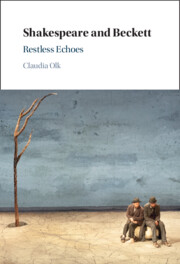Book contents
- Shakespeare and Beckett
- Shakespeare and Beckett
- Copyright page
- Contents
- Acknowledgements
- Abbreviations
- Introduction
- Chapter 1 Shakespeare and Beckett on the Edges
- Chapter 2 Molecular Shakespeare – Beckett Reading Shakespeare through Joyce
- Chapter 3 ‘Some remains’: Beckettian and Shakespearean Echoes
- Chapter 4 Purgatory and Pause – Shakespeare, Dante and the Lobster
- Chapter 5 ‘[It is] winter/Without journey’ – Still Lifes in Beckett and Shakespeare
- Chapter 6 Endgames
- Chapter 7 Theatres of Sleep
- Conclusion
- Bibliography
- Index
Chapter 3 - ‘Some remains’: Beckettian and Shakespearean Echoes
Published online by Cambridge University Press: 19 January 2023
- Shakespeare and Beckett
- Shakespeare and Beckett
- Copyright page
- Contents
- Acknowledgements
- Abbreviations
- Introduction
- Chapter 1 Shakespeare and Beckett on the Edges
- Chapter 2 Molecular Shakespeare – Beckett Reading Shakespeare through Joyce
- Chapter 3 ‘Some remains’: Beckettian and Shakespearean Echoes
- Chapter 4 Purgatory and Pause – Shakespeare, Dante and the Lobster
- Chapter 5 ‘[It is] winter/Without journey’ – Still Lifes in Beckett and Shakespeare
- Chapter 6 Endgames
- Chapter 7 Theatres of Sleep
- Conclusion
- Bibliography
- Index
Summary
This chapter considers the conceptual function of the echo as a metaphor for processes of intertextual dialogue and transformation. When thinking about the character that Shakespeare’s texts assume in Beckett’s works, instead of terms like adaptation, quotation or association, it is the notion of echo that aptly describes Beckett’s ways of engaging with his predecessor and materializing this engagement in the theatrical performance. This chapter regards the echo both as a principle of composition and an immanent figuration that is realized in the theatrical performance. Matter and materiality, stones and bones in Beckett’s works very often become a metonymy for the text itself in that they expose its opacity and resistance, and, at the same time, render it immortal as a kind of petrified lacuna. The chapter considers Beckett’s use of the materiality of stones and bones and reads Happy Days with Romeo and Juliet, Cymbeline and Hamlet.
- Type
- Chapter
- Information
- Shakespeare and Beckett , pp. 73 - 96Publisher: Cambridge University PressPrint publication year: 2023

